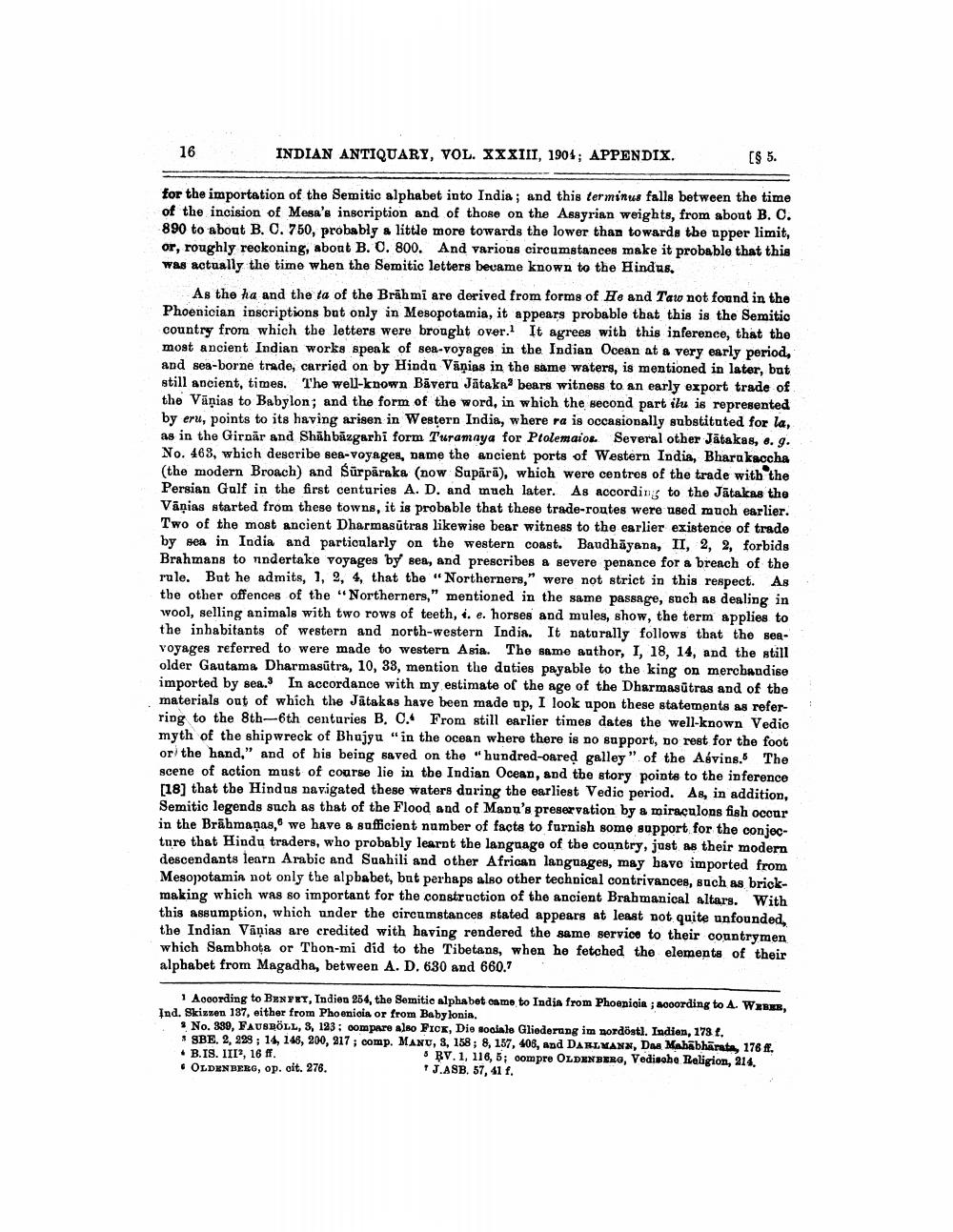________________
16
INDIAN ANTIQUARY, VOL. XXXIII, 1904; APPENDIX.
[$ 5.
for the importation of the Semitic alphabet into India, and this terminus falls between the time of the incision of Mesa's inscription and of those on the Assyrian weights, from about B.O. 890 to about B. 0.750, probably a little more towards the lower than towards the upper limit, or, roughly reckoning, about B. O. 800. And various circumstances make it probable that this was actually the time when the Semitic letters became known to the Hindus,
As the ha and the ta of the Brāhmi are derived from forms of He and Taw not found in the Phoenician inscriptions but only in Mesopotamia, it appears probable that this is the Semitic country from which the letters were brought over. It agrees with this inference, that the most ancient Indian works speak of sea-voyages in the Indian Ocean at a very early period, and sea-borne trade, carried on by Hinda Vāņias in the same waters, is mentioned in later, but still ancient, times. The well-known Bāveru Jātaka) bears witness to an early export trade of the Vāņias to Babylon; and the form of the word, in which the second part ilu is represented by eru, points to its having arisen in Western India, where ra is occasionally substituted for la, as in the Girnär and Shāh bāzgarbi form Turamaya for Ptolemaios. Several other Jātakas, e.g. No. 463, which describe see-voyagen, dame the ancient ports of Western India, Bharakaccha (the modern Broach) and Surpäraka (now Sapārā), which were centres of the trade with the Persian Galf in the first centuries A. D. and much later. As according to the Jātakas the Vänias started from these towns, it is probable that these trade-routes were used much earlier. Two of the most ancient Dharmasūtras likewise bear witness to the earlier existence of trade by sea in India and particularly on the western coast. Baudhāyana, II, 2, 2, forbids Brahmans to undertake voyages by sea, and prescribes a severe penance for a breach of the rule. But he admits, 1, 2, 4, that the "Northerners," were not strict in this respect. As the other offences of the "Northerners," mentioned in the same passage, such as dealing in wool, selling animals with two rows of teeth, i. e. horses and mules, show, the term applies to the inhabitants of western and north-western India. It Datorally follows that the seavoyages referred to were made to western Asia. The same author, I, 18, 14, and the still older Gautama Dharmasutra, 10, 38, mention the daties payable to the king on merchandise imported by sea. In accordance with my estimate of the age of the Dharmasūtras and of the materials out of which the Játakas have been made up, I look upon these statements as referring to the 8th-6th centuries B. C. From still earlier times dates the well-known Vedic myth of the shipwreck of Bhajgu "in the ocean where there is no support, no rest for the foot or the hand," and of his being saved on the "hundred-oared galley" of the Asvins. The scene of action must of course lie in the Indian Ocean, and the story points to the inference [18] that the Hindus navigated these waters during the earliest Vedie period. As, in addition, Semitic legends such as that of the Flood and of Manu's preservation by a miraculons fish occur in the Brāhmaṇas, we have a sufficient number of facts to furnish some support for the conjecture that Hindu traders, who probably learnt the language of the country, just as their modern descendants learn Arabic and Suahili and other African languages, may bavo imported from Mesopotamia not only the alphabet, but perhaps also other technical contrivances, such as brickmaking which was so important for the construction of the ancient Brahmanical altars. With this assumption, which under the circumstances stated appears at least not quite unfounded, the Indian Vāņias are credited with having rendered the same service to their countrymen which Sambhota or Thon-mi did to the Tibetans, when he fetched the elements of their alphabet from Magadha, between A. D. 630 and 660.7
1 According to BANYXY, Indien 254, the Semitic alphabet came to India from Phoenigin ; according to A. WEB, Ind. Skizzen 187, either from Phoenicia or from Babylonia.
No. 330, FAUSRÖLL, 3, 123: compare also Pick, Die sociale Gliederung im nordöstl. Indien, 178 1. * GBE, 2, 229; 14, 145, 200, 217; comp. MANU, 8, 158; 8, 157, 106, and DAHLMANN, Das Mahabharata, 176 ff. . B.IS. 111?, 16 ff.
• BV.1, 116,5; compre OLDENBERG, Vedische Religion, 214. • OLDENBERG, op. cit. 276.
+ J.ASB, 57, 41 f.




